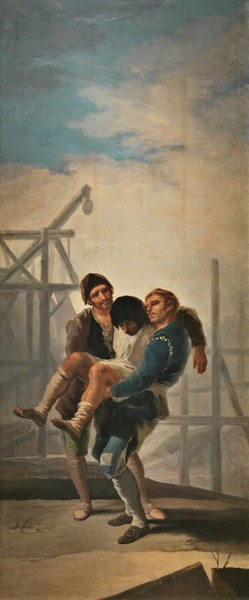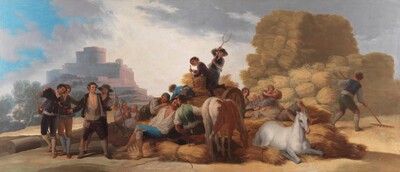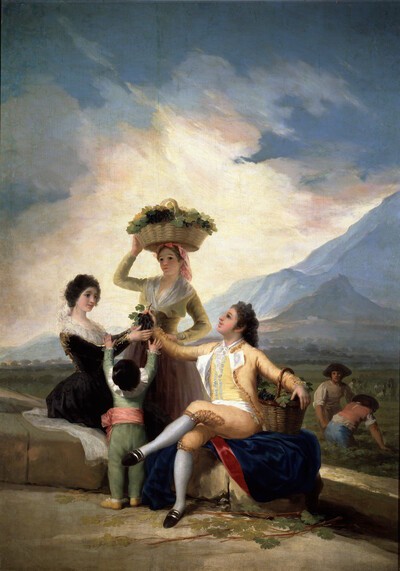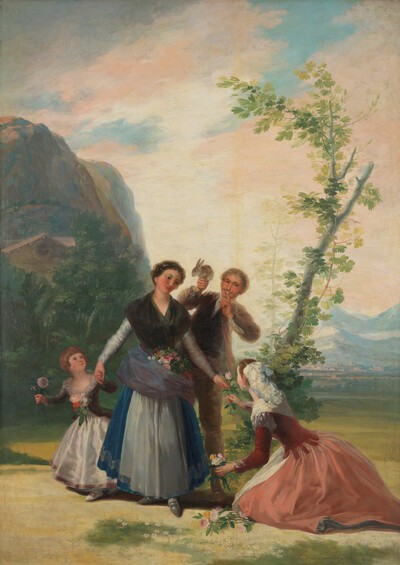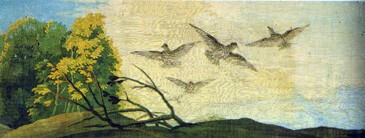- Cronología
- 1786 - 1787
- Ubicación
- The Prado National Museum. Madrid, Madrid, Spain
- Dimensiones
- 268 x 110 cm
- Técnica y soporte
- Oil on canvas
- Reconocimiento de la autoría de Goya
- Documented work
- Titular
- El Prado National Museum
- Ficha: realización/revisión
- 13 Dec 2009 / 13 Jun 2023
- Inventario
- (P00796)
- Otros títulos:
-
See The Flower Girls.
The tapestry would have hung on the east side of the room, making a pair with that of Poor Children at the Well.
In this tapestry cartoon, we can appreciate a dramatic change in the subject matter that Goya had us accustomed to seeing in this type of work. Although the artist keeps the focus on the people, we move away from the jovial, happy scenes of fairs and amusement towards the representation of social themes, which make their appearance in this same batch of works with The Snowstorm, Poor Children at the Well and this work, collectively known as the winter trilogy.
Goya presented Charles III with the sketch for this work in which the composition is exactly the same but the expressions on the faces of the characters are dramatically different. In the sketch the figures appear happy; two workers cast each other sideways glances, amused at the inebriated state of their companion, who they have to carry along. The king must have found the subject amusing but would have been surprised to see the finished cartoon, in which the men have swapped their smiles for looks of deep concern for their injured workmate, who appears to have fallen from the scaffolding.
Some writers have drawn connections between this theme and a decree passed by Charles III in 1784 which demanded that works managers pay damages in the event of workers being injured in falls and established a system of aid for the injured and their families. Goya may have sought to score points in the eyes of the king and his ministers, interested in dignifying common trades, by representing precisely one of these work accidents.
Nordström has justified the place of The Injured Mason within the winter trilogy by pointing out that, according to the iconography of Ripa, in traditional calendars the work of the mason always illustrated the month of November.
No tapestry of this piece has survived; this is the only cartoon that no longer has its corresponding tapestry. Sambricio interpreted this as proof that the cartoon had displeased Charles III, but a copy later appeared in the dining room of the Infante Don Francisco de Paula Antonio, the whereabouts of which are today unknown.
-
Goya in the PradoThe National Gallery of ArtWashington1976from May 6th to 31st 1976cat. 2
-
Les chefs-d’œuvre du Musée du PradoMusée d’Art et d’HistoireGeneva1939consultant editors Fernando Álvarez de Sotomayor y Pedro Muguruza Otaño. From June to September 1939cat. 37
-
GoyaPalacio de PedralbesBarcelona1977from April 12th to June 30th 1977cat. 10
-
Goya y el espíritu de la IlustraciónMuseo Nacional del PradoMadrid1988from October 6th to December 18th 1988. Exhibited also at Museum of Fine Arts, Boston, January 18th to March 26th 1989; The Metropolitan Museum of Art, Nueva York, May 9th to July 16th 1989, Madrid curator Manuela B. Mena Marqués, scientific directors Alfonso E. Pérez Sánchez and Eleanor A. Sayrecat. 13
-
Goya. 250 AniversarioMuseo Nacional del PradoMadrid1996consultant editor Juan J. Luna. From March 29th to June 2nd 1996cat. 40
-
Goya luces y sombrasCaixaForumBarcelona2012consultant editors José Manuel Matilla and Manuela B. Marqués. From March 16th to June 24th 2012cat. 9
-
Madrid2017
-
L'œuvre peint de Goya. 4 volsParís1928-1950vol. I, p. 93, cat. 34
-
Tapices de GoyaMadridPatrimonio Nacional1946pp. 141, 147-148, 254, cat. 44 y lám. 15
-
Vie et ouvre de Francisco de GoyaParísOffice du livre1970pp. 79, 97, cat. 266 y p. 70 (il.)
-
BarcelonaPolígrafa1970vol. I, p. 225, cat. 225
-
L’opera pittorica completa di GoyaMilanRizzoli1974p. 102, cat. 203
-
Francisco de Goya, 4 vols.ZaragozaCaja de Ahorros de Zaragoza, Aragón y Rioja1980-1982vol. II, p. 43 y p. 21 (il.)
-
Francisco de Goya, cartones y tapicescol. col. "Espasa Arte"Espasa Calpe1987pp. 140, 142, 143, 147, 157, cat. 48C y
-
Goya, Saturno y melancolía. Consideraciones sobre el arte de GoyaStockholmAlquimis & Wiksell1962pp. 70-73 y p. 69 (il.)
-
Francisco de Goya. Los cartones para tapices y los comienzos de su carrera en la corte de Madridcol. col. "Ensayos de Arte Cátedra"MadridCátedra1987p. 228 y p. 227 (il.)
-
Goya. 250 AniversarioMadridMuseo del Prado1996p. 230, cat. 40 y p. 121 (il.)
-
Salas del Palacio Real de El Pardo para las que se tejieron tapices sobre cartones de Francisco de Goya: identificación de las habitaciones y ajuste de las obras de Goya en los alzados de las paredesin HERRERO CARRETERO, Concha (curator, Tapices y cartones de Goya (catalogue of the exhibition organizated at the Palacio Real de Madrid, from may to june 1996)MadridPatrimonio Nacional, Goya 96, Lunwerg1996p. 165 (il.)
-
Goya en Madrid. Cartones para tapices 1775-1794MadridMuseo Nacional del Prado2014p. 258
-
ZaragozaGobierno de Aragón y Fundación Bancaria Ibercaja2017p. 187
